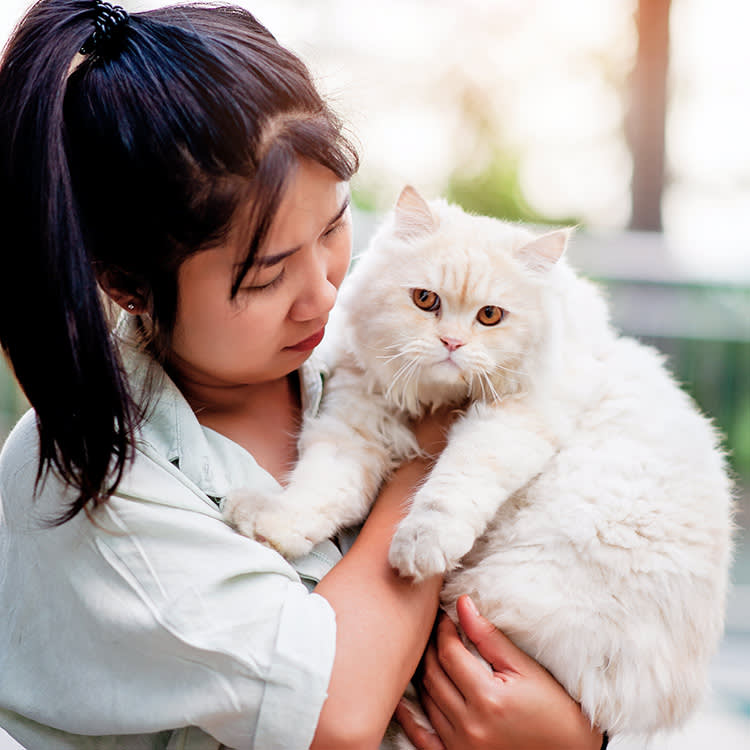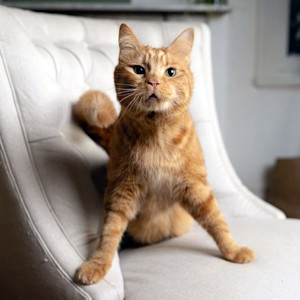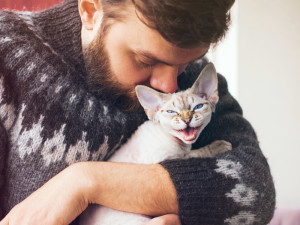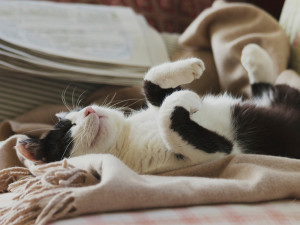Neurological Disorders in Cats
Here are some signs to look for.

Share Article
In This Article:
What Causes Sudden Neurological Issues in Cats? Symptoms of Neurological Issues in Cats Eight Common Cat Neurological Issues
If you and your cat have been hanging out for a few years, you’ve probably gotten accustomed to each other’s quirks and occasional odd behaviors. But what if your cat suddenly starts acting strangely, and they don’t seem to have any control over it? If your cat is suddenly staring off into space, they may not be plotting their world domination — they may be showing signs of a neurological problem. Let’s talk about cat neurological issues.
What causes sudden neurological issues in cats?
Neurological disease in cats refers to any issue that affects a cat’s brain, spinal cord, or nerves. Signs can be so subtle that they’re barely noticeable or so severe that they completely alter a cat’s abilities and behaviors. A cat can go from leaping across the furniture to barely being able to walk or go from being vocal and expressive to being depressed and poorly responsive. Cats can also have seizures from some neurological diseases. Dramatic changes like this can be frightening, especially when they come on suddenly.

Cats can develop neurological issues in response to:
Head trauma
Spinal trauma
Infection (bacterial, viral, fungal, or parasitic)
Inflammation
Degenerative disease
Congenital disease
Symptoms of neurological issues in cats
Neurological issues in cats can manifest as changes in a cat’s alertness, behavior, sensory abilities, and movement. A cat can appear generally unwell with no clear link to a neurological issue — until neurological symptoms surface. These signs should never be ignored. If you spot any of these signs, take your cat to the vet right away:
Seizures
Difficulty walking
Dragging any limbs
Ataxia (unsteady gait)
Walking in circles
Head tilt
Rapid eye movement
Dulled mental activity
Disorientation
Head pressing
Eight common cat neurological issues
Epilepsy
When vets talk about epilepsy, we are typically referring to primary epilepsy, a condition in which a pet has seizures for no identifiable cause. Primary epilepsy occurs less frequently in cats than it does in dogs. An epileptic cat will have abnormal brain activity that leads to either generalized or focal seizure activity.
Generalized (or grand mal) seizures involve full-body convulsions and a temporary loss of consciousness. Cats may also drool and lose control of their bowels or bladder during a seizure. Focal seizure activity, on the other hand, is less dramatic. A cat having a focal seizure will typically display abnormal, uncontrollable movement of just one area of their body, like twitching of the face or a limb.
Because idiopathic epilepsy means seizures without a known cause, a diagnosis requires ruling out other possible known causes first. So, if your cat starts having seizures, your vet may recommend blood work and neurological screening, which involves an MRI and cerebrospinal fluid (CSF) tap. Treatment for epilepsy involves medical management. Epilepsy in cats can oftentimes be controlled with daily oral medications and periodic blood work to ensure the medication is well-tolerated.
Brain tumors
When a cat has seizures, one of those “known causes” we recommend searching for is a brain tumor. The three most common types of brain tumors in cats are meningiomas, lymphoma, and pituitary tumors, in that order. Meningiomas make up more than 50 percent of feline brain tumors. They are slow-growing and usually benign, but because they put pressure on the brain, they still cause symptoms. Symptoms of brain tumors in cats can include seizures, behavior changes, walking in circles, wobbly walking, and blindness.
Many people assume that nothing can be done for a cat with a brain tumor, but that’s not true. Treatment options can include surgery, radiation, chemotherapy, and medications. Cats with meningiomas generally do well with surgical removal. Additionally, medications can help control seizures, and steroids can possibly shrink the size of a tumor.
Vestibular disease
The vestibular system is responsible for maintaining a cat’s sense of balance. A cat’s vestibular system can be disrupted by tumor growth, infection, inflammation, trauma or from an unidentifiable cause. In cats, the most common causes of vestibular disease are inner ear infections and nasopharyngeal polyps. Vestibular disease in cats often results in loss of balance and coordination, a head tilt, and rapid eye movement (nystagmus).
Treatment may include treatment for an inner ear infection, polyp removal, or specific treatment for any underlying disease that is diagnosed. If no cause is identified, cats are treated with supportive care, which can include anti-nausea medications and taking extra precautions to ensure that a cat doesn’t fall and injure themselves due to lack of coordination.
Spinal issues
Cats can also develop spinal disease that can impact their strength and ability to walk. Intervertebral disc disease in cats occurs when the jelly-like interior of a disc hardens, becomes displaced, and applies pressure to the spinal cord. This can occur due to degeneration or trauma, but occurs in cats less frequently than it does in dogs.
Cats can also develop spinal issues secondary to bacterial infections or viral infections like feline infectious peritonitis (FIP). Cats with spinal issues can display pain, hindlimb weakness, reluctance or unwillingness to jump, dragging of the hindlimbs, or loss of bladder or bowel control.
Treatment for spinal issues depends on the cause and the severity of signs. Some cats can recover with medical management, which may include pain control, anti-inflammatory medications, and strict rest. In some cases of IVDD, surgery may be recommended.
Cerebellar hypoplasia
Cerebellar hypoplasia is a condition in which the cerebellum — the part of the brain responsible for coordination and fine motor skills — does not develop properly. If a pregnant cat or newborn kitten is infected with panleukopenia (feline distemper), there is a risk that the kitten’s cerebellum will be underdeveloped.
Kittens with cerebellar hypoplasia display very distinct symptoms including a wobbly gait (ataxia), dramatic limb movements, and body and head tremors. These signs become apparent as a kitten grows and starts to walk around.
Cerebellar hypoplasia can be confirmed by performing an MRI, but in my experience, most kittens are diagnosed based on their history and clinical signs.There’s no treatment for the condition, but cat parents can provide a safe home by keeping their kitty indoors and making environmental changes that reduce chance of injury. Kittens with mild to moderate symptoms of cerebellar hypoplasia can grow up to be happy, loving pets, just a little clumsy and unsteady on their feet.
Hyperesthesia syndrome
Feline hyperesthesia syndrome is a condition in which a cat’s skin becomes hypersensitive and twitchy. The cause for this condition is unknown, but a popular theory is that these cats are experiencing a form of maladaptive pain, or discomfort in the absence of trauma. Another theory is that feline hyperesthesia syndrome is a type of compulsive behavior disorder.
Cats with hyperesthesia syndrome will have muscle spasms along their back and episodes of tail chasing, intense overgrooming, vocalization, running and jumping. It’s often difficult to stop a cat from licking and chewing on themselves during an episode, and they will groom themselves to the point of self-trauma.
There is no treatment for hyperesthesia that has been consistently effective. Stress reduction is a common recommendation. Some vets and cat parents have seen success with medications, but results vary.
Cat dementia
Feline cognitive dysfunction, or cat dementia, is a common age-related change in senior cats. As cats age, their brains actually shrink in size and accumulate protein. These changes impair the brain’s cognitive abilities due to decreased communication between cells. Senior cats with cognitive dysfunction will often show changes beyond the typical “slowing down” that pet parents expect.
Cats with dementia can display disorientation, restlessness, staring off, ignoring people and other pets, house soiling, vocalization, and changes in their sleep, eating, and grooming habits. Treatment for feline cognitive dysfunction typically involves a combination of medication, supplements, enrichment, and environmental changes.
Meningitis and encephalitis
Meningitis refers to inflammation of the meninges (the membrane that covers the brain and spinal cord). Encephalitis refers to inflammation of the brain. Oftentimes, if inflammation is present, it involves both the brain and the meninges — a condition called meningoencephalitis.
Cats can develop meningioencephalitis from infections caused by bacteria, viruses, fungi, and parasites. Feline infectious peritonitis (FIP) is the most common cause in cats. The disease can also be immune-mediated or have no detectable cause. Symptoms of meningitis or encephalitis in cats can include seizures, blindness, neck pain, dull mentation, wobbly walking, and fever.
Treatment for meningitis or encephalitis in cats depends on the cause. If there is an underlying infection, treatment calls for medication to treat the infection like antibiotics or antifungal medication. Cats with immune-mediated disease may benefit from steroids. Treatment may also include supportive care to address pain, fever, or dehydration.
When to see a vet
Any cat that is displaying neurological signs should be seen by a veterinarian right away. When evaluating a cat with neurological symptoms, I will start with a medical history and physical exam. My physical exam will include a neurological exam, where I evaluate the cat’s reflexes. Blood work can give me an indication of whether or not there’s an obvious infection, but may not show what the cat is infected with.
Many times I’ll recommend evaluation by a veterinary neurologist, so that a full neurological work up can be performed. This often includes collecting a sample of cerebrospinal fluid (CSF) to look for organisms or abnormal cells and an MRI. These are performed under anesthesia.
If you encounter a cat with neurological signs that is unknown to you or has an unknown vaccination history, it’s best to contact local animal control and let them handle it. Remember: rabies is a neurological disease that is contagious and deadly. Stay safe and keep your distance.
Bottom line
Neurological issues can affect a cat’s mentation, behavior, sensory abilities, and movement.
There are many possible causes for neurological issues in cats, including trauma, infection, inflammation, tumors, and congenital disease. If your cat is displaying signs of neurological disease, it’s important to have them evaluated by a vet right away. Evaluation by a veterinary neurologist may be recommended to find a diagnosis and appropriate treatment plan.
References
Callanan, John J. “Meningitis, Encephalitis, and Encephalomyelitis in Animals.” Merck Veterinary Manual, 2 Mar. 2021, www.merckvetmanual.com/nervous-system/meningitis-encephalitis-and-encephalomyelitis/meningitis-encephalitis-and-encephalomyelitis-in-animalsopens in new tab.
Cohn, Leah, and Etienne Cote. Cote's Clinical veterinary Advisor: Dogs and Cats - E-Book (4th Edition). Elsevier - OHCE, 2019.
“Congenital and Inherited Cerebellar Disorders in Animals - Nervous System.” Merck Veterinary Manual, www.merckvetmanual.com/nervous-system/congenital-and-inherited-anomalies-of-the-nervous-system/congenital-and-inherited-cerebellar-disorders-in-animalsopens in new tab.
Pakozdy, A et al. “Epilepsy in cats: theory and practice.” Journal of veterinary internal medicine vol. 28,2 (2014): 255-63. doi:10.1111/jvim.12297opens in new tab.
Thomas, William B. “Inflammatory and Infectious Diseases of the Spinal Column and Cord in Animals.” Merck Veterinary Manual, 29 Oct. 2021, www.merckvetmanual.com/nervous-system/diseases-of-the-spinal-column-and-cord/inflammatory-and-infectious-diseases-of-the-spinal-column-and-cord-in-animalsopens in new tab. Accessed 8 Apr. 2025.
Troxel, Mark T, et al. Feline Intracranial Neoplasia: Retrospective Review of 160 Cases (1985-2001). Vol. 17, no. 6, 1 Nov. 2003, pp. 850–859, https://doi.org/10.1111/j.1939-1676.2003.tb02525.xopens in new tab. Accessed 7 Aug. 2023.

Dr. Alycia Washington, DVM, MS
Alycia Washington is a small-animal emergency veterinarian with over 10 years of experience based in North Carolina. She works as a relief veterinarianopens in new tab and provides services to numerous emergency and specialty hospitals. She also works as a veterinary writer with a focus on educating pet parents.
Related articles
![Dark-haired woman holding her ragdoll cat]()
7 “Purebred” Cat Breeds Likely to Suffer from Genetic Disorders
Especially while shelters are overcrowded, consider adopting a cat.
![cat meowing]()
Why Does My Cat Meow So Much? Reasons Your Cat Meows Excessively
How to decode your cat’s love language when one meow has many meanings.
![A dog cuddled up next to its owner on the couch]()
Certain Flea and Tick Meds Can Cause Adverse Reaction in Pets, FDA Warns
Some preventatives have been linked to neurological issues, like stumbling, seizures, and twitching in dogs and cats. Here’s what you need to know.
![Cute tabby cat playing with roll of toilet paper.]()
How to to Spot, Treat, and Prevent Pica in Your Cat
There may be a reason your cat can’t stop putting your hair ties in their mouth.
![Black and White cat with its eyes closed laying on its back on a scarf]()
Is My Cat Happy?
In this excerpt from her new book, Purr: The Science of Making Your Cat Happy, animal behaviorist Zazie Todd shares science-backed insights into our cats’ moods.
Can Cats Have ADHD?
A question you may be asking after you observe any number of their behaviors...







